Seeing a new species is always exciting and spotting a southern African vagrant, a Cape Gannet, at Point Danger was a real buzz.
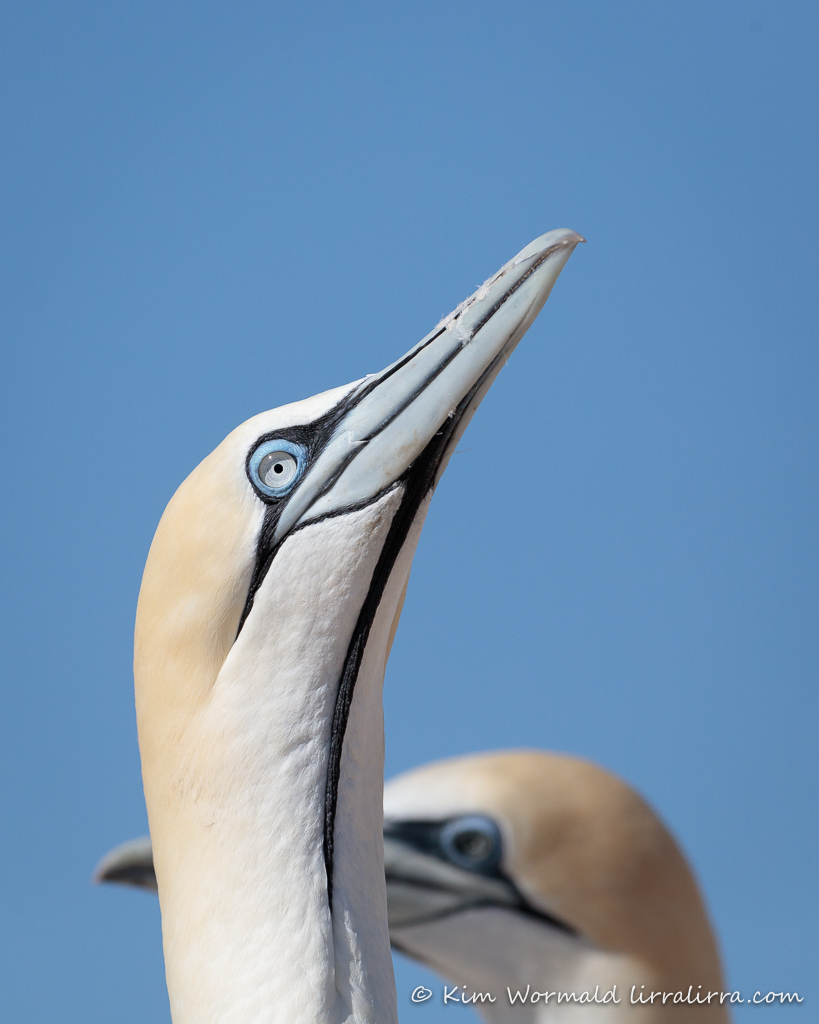
Cape Gannet (foreground) (Morus capensis)
Australasian Gannet (background) (Morus serrator)
1/2500, f/10, ISO 800
This week I made a fairly impromptu dash to Point Danger, Portland with an adventurous friend. This time last year there were only a handful of gannets left on the rock, including a couple of fluffy babies and a dozen or so older chicks. This year the gannets bred earlier than usual and ordinarily there would have been virtually no birds to watch. According to the beaut and knowledgable volunteers it is very strange to have so many adults returning to the rock once the chicks have fledged.
As the sun was dropping behind the graceful wind turbines I saw a bird in flight that seemed to have a longer black, featherless, gular stripe than the Australasian Gannets. I was 80% sure but hadn’t heard whether there were any Cape Gannets around so was prepared to be told it was an unlikely sighting. The following morning the bird above landed nearby and the lengthy gular stripe was obvious, as were the darker face markings and paler head and eye.
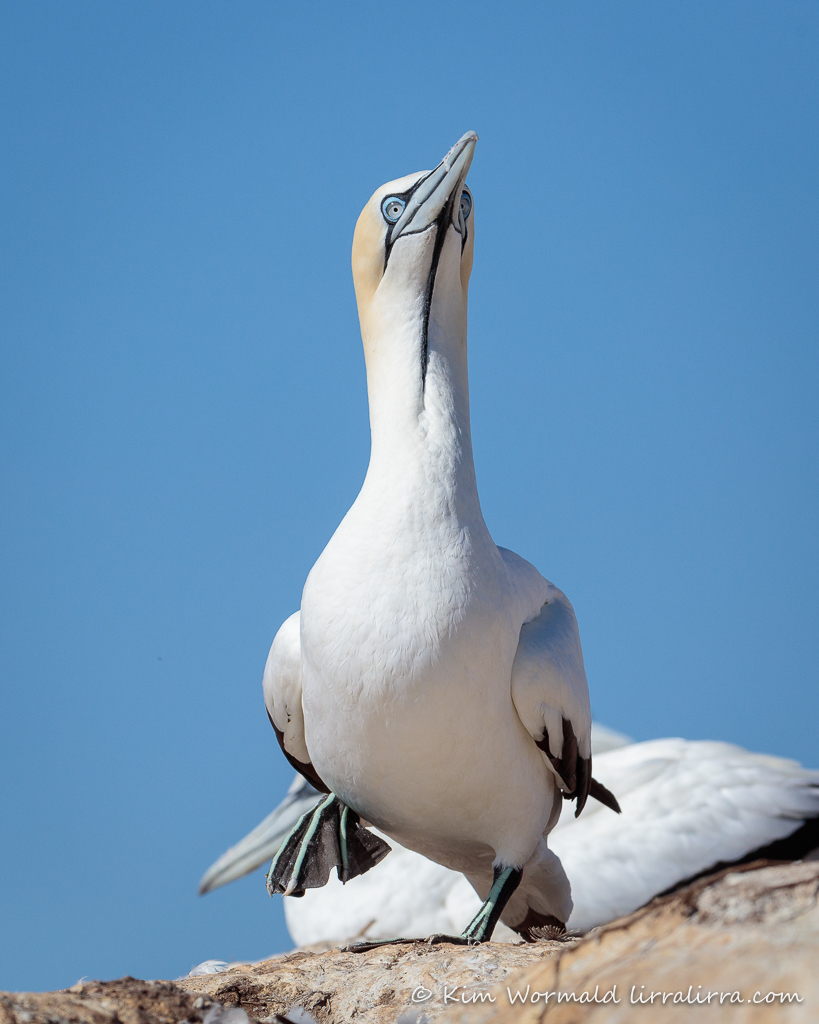 Cape Gannet (foreground) (Morus capensis)
Cape Gannet (foreground) (Morus capensis)
Australasian Gannet (background) (Morus serrator)
1/2500, f/10, ISO 800
Cape Gannets are often tricky to spot amongst a large, active group but there are other clues as well as the ones I mentioned. They are slightly bigger, weighing 2.5-3.0kg and have a deeper call which can be heard despite the general cacophony. They have an all-black tail while Australasian Gannets generally have white outer tail feathers; according to The Australian Bird Guide this feature isn’t 100% diagnostic as some Aussie gannets also have all black-tails. The stripes on the legs, feet and toes of Cape Gannets is brighter than the corresponding stripes on the Australasian Gannets (see image below for comparison).
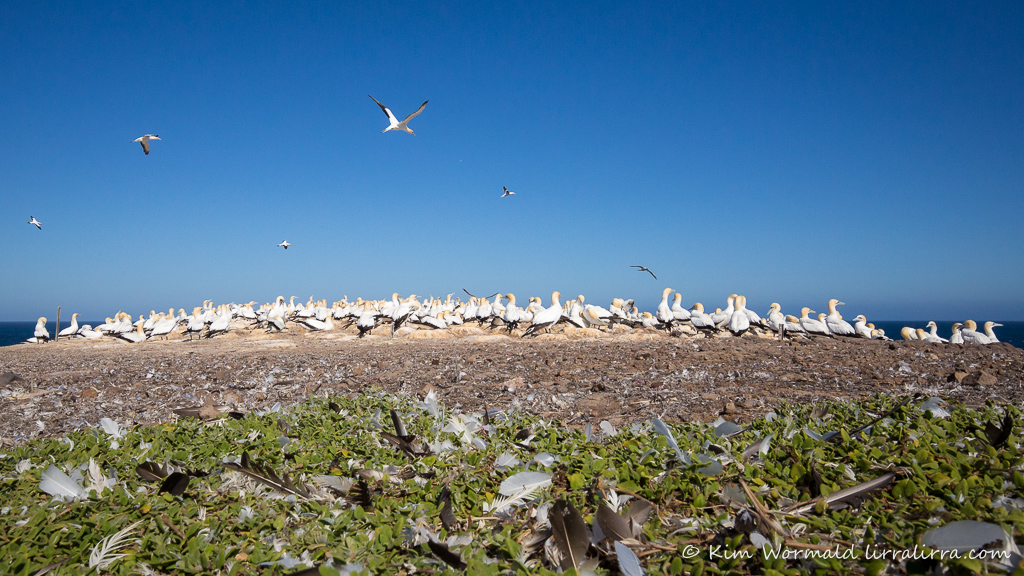 Point Danger, Portland, Victoria
Point Danger, Portland, Victoria
Australia’s only mainland gannet breeding colony
1/2500, f/16, ISO 1600
I usually carry my wide angle lens with me but I rarely use it, I’m always worried that some amazing bird will appear in front of me and I won’t have a long lens in my hand. I’m glad I made a brief exception at Point Danger because I think the image above gives more of an idea of the headland. To imagine you are there you need to add a lot of noise, a strong smell of guano and a smattering of fresh poop decorating your clothes, shoes and camera bag – luckily the rest of me and the camera and lens escaped being white-washed.
I almost forgot to mention the rocks digging into me as I laid, knelt or sat on the ground (I was flat on the ground for the image above, which added to the general mess I was in). And the wind whipped up and was surprising cold, sometimes I pressed the shutter button from shivering rather than intent.
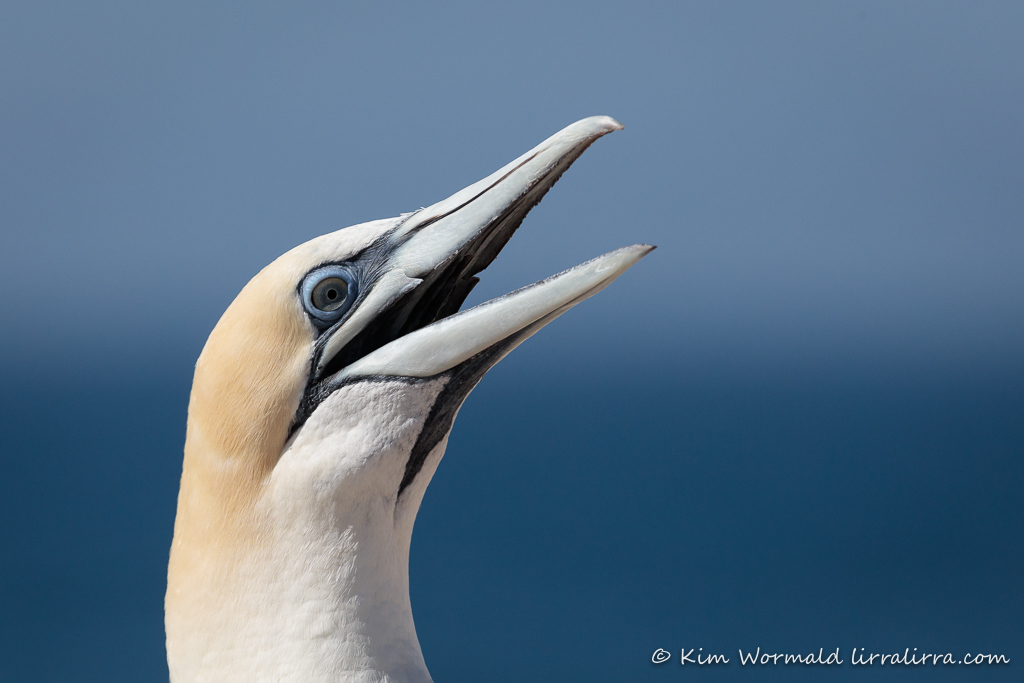 Australasian Gannet (Morus serrator)
Australasian Gannet (Morus serrator)
1/2500, f/10, ISO 800
The image above shows an Australasian Gannet for comparison. The gular stripe finishes just beneath the chin and the facial colouring is clearly different. The sea and cloudless sky were beautifully coloured.
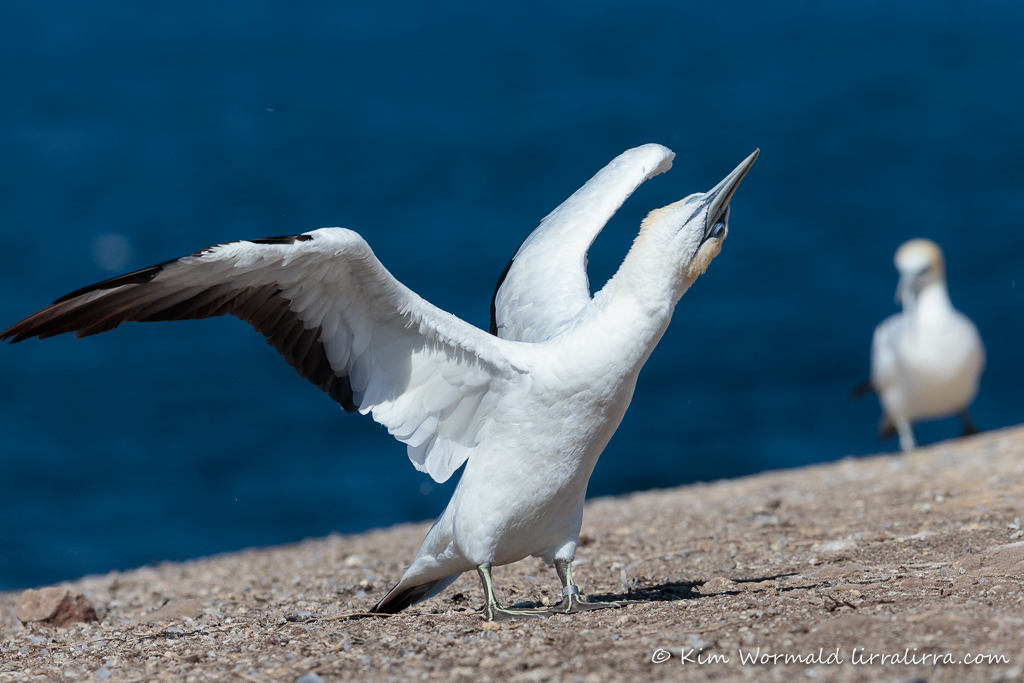 Australasian Gannet (Morus serrator)
Australasian Gannet (Morus serrator)
1/3200, f/9, ISO 800
When I was looking through my images for comparison shots this one made me smile. This cooperative bird seemed to know that I was looking for opportunities to photograph the Aussie bird’s gular stripe and that a comical pose would be much appreciated.
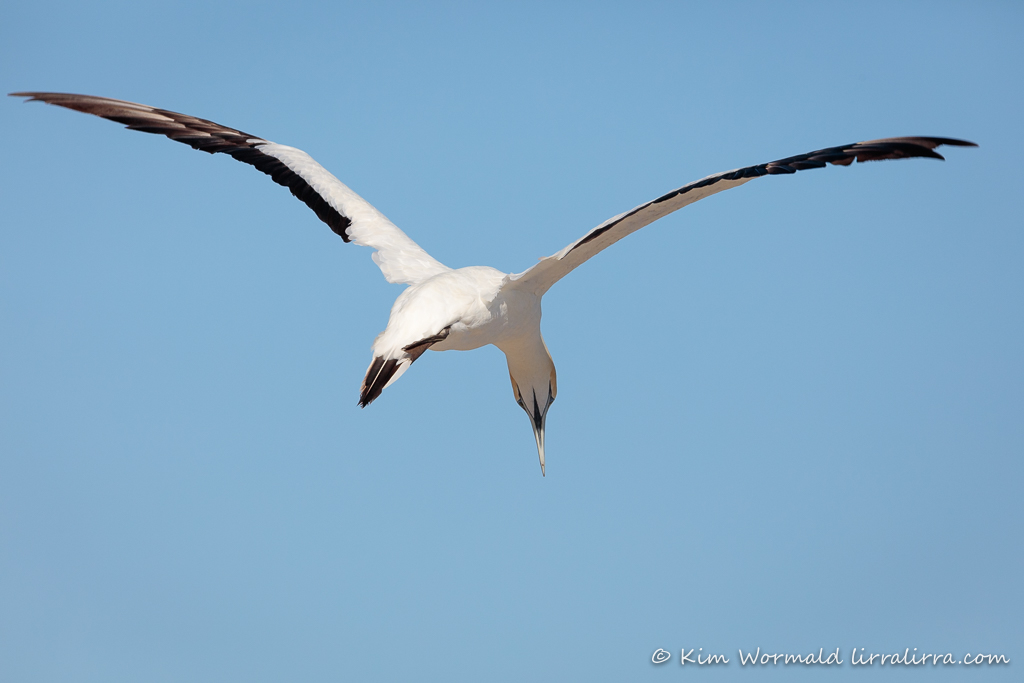 Australasian Gannet (Morus serrator)
Australasian Gannet (Morus serrator)
1/3200, f/9, ISO 800
And the gular stripe shot above made me smile too.
 Cape Gannet (foreground) (Morus capensis)
Cape Gannet (foreground) (Morus capensis)
Australasian Gannet (background) (Morus serrator)
1/2500, f/10, ISO 800
Although the breeding season should be just about over many birds were carrying sticks, seaweed and one pair were even examining a fairly hefty piece of rope. I photographed birds mating so am wondering whether or not another batch of eggs will be layed, it seems unlikely but I am very curious and hope to head back in a couple of weeks.
Happy birding
Kim
~ thank you for visiting and commenting
~ use the subscribe box if you’d like to receive a weekly email when lirralirra is updated

Your usual excellent standard, Kim. Never fail to mention this site to others.
Phonic oddity; standing on a sundeck in Eltham this arvo, was magically transported by birdsong to Tropical Australia. It was uncanny–from the topmost foliage of a neighbouring Yellow Box, came the unmistakable call of a Black Butcherbird, no less.
It was of course a Pied Currawong. But over twenty minutes of rendering the same phrase, he replicated the timbre and phrasing of the other species perfectly.
Yet the nearest Black Butcherbird must be thousands of klicks away !
How’s that work ?!
Cheers,
John Bond.
Thank you John. That is really fascinating about the currawong’s call. You are super observant!
I received this comment in a strange way, maybe because it included a link. If you’d like to look at the webcam mentioned please google the information given. Thanks to whoever sent the message!
“I hope this link works. For those interested, Nature Conservancy Australia has two live feeds in daylight hours from Pope’s Eye, a rocky reef just inside Port Phillip Bay.
The above water feed has been showing Aussie Gannets and their chicks etc for several months. A great way to watch nature when you’re stuck inside working. (I don’t know exactly where this platform is, although it’s certainly somewhere in the Bay as well.)
No Cape Gannets thus far!”
Dear Kim,
I am so pleased that you visited the gannet colony on Point Danger. It is a wonderful experience, despite the poo and uncomfortable ground. I live nearby and as well as doing the occasional trip inside the gate, I climb the lookout platform to see the gannets. I am pleased you saw the resident Cape Gannets, with the distictive gular stripe. I struggled to see it when last I was there, as the colony was all in residence . There were crowds of gannets being strong, bracing against the wind with their flat feet. The remainder were cruising the sky, attentively searching for food, and as you saw, some returning with nest-making supplies.
Kim, may I post this article on a facebook page called I love Portland Victoria Australia Too, and on mine as well. (Meredith Newman Debens)
Regards Meredith
Thank you for your superb photos and the notes which you write as well. Regards Meredith
Hi Meredith, how fantastic it must be to visit Point Danger so often! This is a quick note to say yes, you are welcome to post the article on the pages you mention. Thanks for sharing information about your recent visit and for your kind comments, Kim
What great timing to be there when the Cape Gannet was there. I have only observed a Gannet colony in NZ but aim to get down to Portland one day to see our local population.
Great shots showing the distinctive gular stripe! I love learning new things from others like you. Thanks so much, Kim! 🙂
I saw my first colony in NZ, trotting out to the colony on horseback and being amazed by the noise and the smell. I hope you get to Portland soon and that the Cape Gannet greets you on arrival 🙂
What a great find Kim. And what wonderful photos – thanks for sharing. I must make my own pilgrimage to this wonderful spot, after all, it’s not as far for me to travel.
Blessings
Neil
You really must Neil! And please let me know how it goes
What a treat – for you and for us.
And despite the discomfort and the mess you wouldn’t have missed it for anything. Would you?
You are absolutely right EC, I loved every poopy, uncomfortable moment
What a wonderful collection of images! They seem like such quirky and entertaining birds. Fascinating to have a visitor from Africa too!
They are fantastic to watch, real characters and they interact in such interesting and comical ways